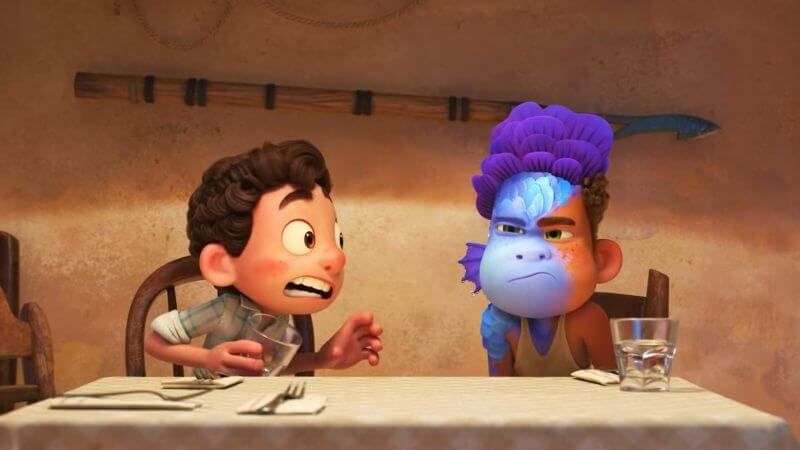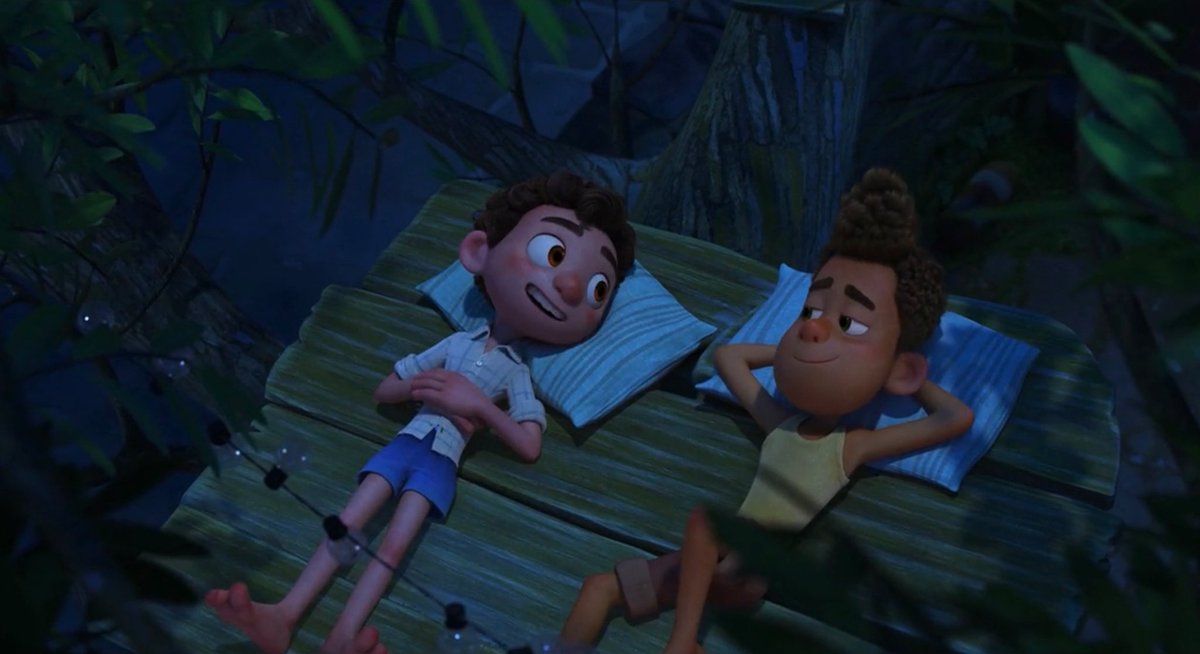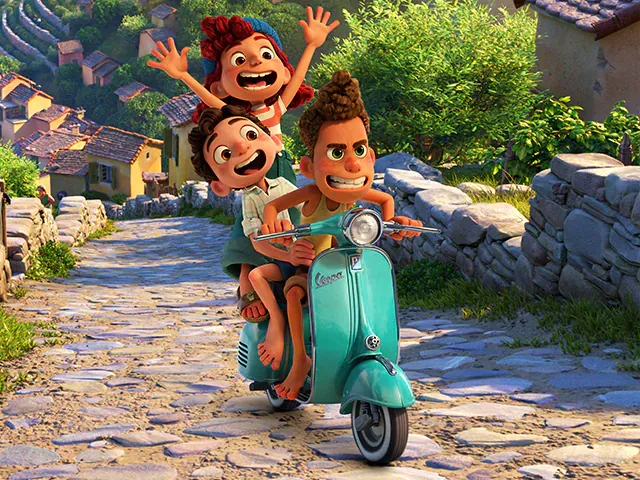Pixar Animation Studio has been responsible for the birth of some of the most popular—and best—movies in Western animation. They expeditiously rose to prominence after introducing full-length computer-animated films into theaters while establishing the tone of their brand. Pixar created original in-house content that would spark a reinvigorated cultural adoration for animation and inspire generations of future artists. Titles such as Toy Story, Finding Nemo, Cars, and countless others have served as staples in modern animated media.
Luca follows the coming-of-age of shape-shifting Luca Paguro and is vastly inspired by director Enrico Casarosa’s youth spent on the Italian seaside. The sea monster teen is privy to a deeper understanding of personal identity while caught between worlds. It was Cararosa who said that Luca "pays homage to Federico Fellini and other classic Italian filmmakers, with a dash of [Hayao] Miyazaki in the mix too.” The film indulges itself in lush Mediterranean landscapes and the warmth of Pixar’s rich sentimental value without having to rely on redundancy. Here's what makes Luca a groundbreaking Pixar movie.
Luca Doesn’t Feel like a Pixar Movie—And That’s Okay
Pixar has settled into the idea that their storytelling must tackle daunting issues in order for their movies to become memorable: embarking on cross-ocean adventures, competing in the World Grand Prix, and saving the world from supervillains who are bitter with vengefulness. Luca, however, prefers to appreciate the wonders of small-scale storytelling. There's no humanity at stake, no world's end on the brink of collapse, and no grand moral conflict that strings tension through the film. The film, instead, refines itself to a small-scope, domestic plot. Its intimacy within itself is where it finds its heart. Other Pixar titles face impossibly large threats; Luca proves that there’s no need for over-ambition in order to be good.
In comparison to past Pixar pictures, there would be a significant amount of screen time dedicated to the underwater metropolis of the sea monsters in order to capture the perspective of the species that keep themselves hidden away from humans. There would be a sprawling exposé that would go to great lengths to make sure that not only Luca and the Paguro family would be introduced, but so would the rest of the deep-sea society. Luca does none of that. Instead, there is utmost attention given to its character writing. While there is screen time devoted to the Paguro family, it doesn't dominate the focal points of the film. There is no larger, interconnected Pixar multiverse that forces itself into the film. In place of such greater grand schemes that feel almost impossible to accomplish, there is the lighter feel of domestic values. The abandonment of world-building is an essential element that gives Luca its more atmospherically minimalist feel.
It Inspires Interpretation of LGBTQ+ Allegory
Wall-E, Soul, and Inside Out have permitted room for personal resonance and have proved themselves to be incredibly introspective. Luca fixates on the coming-of-age of its titular character as he explores life outside the ocean. There's not as much teenage angst or hormonal outburst as there is the want to embrace the understanding of oneself on a deeper level. Luca himself is torn between worlds as a sea monster and a human, and wrestles with the desire to exist in both. He grapples with his obligations to his family and the want to live on land. He is faced with the reality of making a choice and asked to determine what is best for himself. One scene details Luca's mother worrying over how he'll only be accepted as a human; his grandmother replies, “Some people, they’ll never accept him. But some will. And he seems to know how to find the good ones.”
Disney is notorious for queer-baiting across its media and remains guilty of upholding its misleading trend of promising queer representation during a movie's promotional tour, but ultimately reneging on that promis. Luca refuses to label any relationships in the film, consequentially blurring the lines between platonic and romantic intentions between Luca and Alberto. In fact, Cararosa took action and squashed any theories that the two boys at the heart of the film were to be romantically involved, and said “I was really keen to talk about a friendship before girlfriends and boyfriends come in to complicate things.” The director's dismissal of a queer romance influencing the film altogether did not, however, extinguish common LGBTQIA+ tropes working their way into the film and from LGBTQ+ viewers from drawing personal connections to the story. The main theme of "being an outcast" resonates with the idea of closeted queer people concealing their own identities. Despite the cautionary tale of facing rejection due to his sea monster form, Luca "comes out" by venturing on land. His kinship with Alberto, another sea monster teen, acts as a sense of visibility.
The unconfirmed queer narrative discusses self-acceptance despite the fear of being ostracized. The film concludes on an uplifting note of the human community accepting Luca for who he is overlooking the prejudice of the hatred of sea monsters (which can be coded as homophobia). After the truth behind Luca and Alberto's identities are revealed to the others, their right to exist isn't questioned. Any assumption of how "sea monsters" act, behave, or are portrayed, is erased. This can relate directly back to the LGBTQIA+ community's right to be conventionalized, even if some identities may face stereotypes and misunderstandings.
The Animation Style Breaks From Tradition
Luca's most striking significance that first meets the eye is not the queer allegory that lies beneath its surface, but the unconventional art style behind it. The traditional ultra-realistic animation style that Pixar has defined its brand by is not found here. Cararosa was adamant that Luca was to take on a more "artistic, illustrated feel." Effects supervisor Jon Reisch said “We started with what we knew and what we were most comfortable with, in this more physically-based world where we come from—so all of the simulation tools had this sense of physics and motion that really wants to result in this more photorealistic look.” There are no doe-eyed women with exceedingly long lashes and thinned waistlines, no unrealistically obtainable proportions or near-perfect body shapes are being depicted—the style is cartoonish, but not satirical.
Japanese 2D animation styles were also credited as heavy influences when bringing Luca to life. Cararosa reflects on his time watching Japanese animation while growing up in 1980s Italy. He explained the direct impact that the diversity in animation left on him when playing with how Luca would ultimately look. “Woodblock prints—beautiful simplifications of reflections, for example—are intriguing and appealing,” the director said. “They seem to inspire much of the Japanese animation and watercolors I admire, so we spent a lot of time looking at that.” Animation Supervisor Mike Venturini said that Pixar had to develop specialized technology in order to achieve a hybrid art style that broke their previous mold. In order to accomplish a new means of illustration for the film, the team was asked to reconsider their traditional approach.
Director of photography David Bianchi contributes to the sense of creativity behind Luca: “It still feels like a CG film, but you can sense the hand[s] of the artists touching it.” The teams of artists behind the film source medieval descriptions of sea monsters as the inspirations for the aquatic forms of its fish people. At the same time, there's a contraction from Character Art Director Deanna Marsigliese. "I also wanted to stay true to their decorative origins. You’ll notice beautiful, irregular scale patterns as if carved by hand," she said, "You’ll see different kinds of facial fins, scalloped crests, sharp spines and webbing, and curlicues within the tails. And as our sea monsters age, these features only grow bigger and bolder. They’re beautiful creatures, and combined with their iridescence and gorgeous colors, could pass for pieces of costume jewelry.”
The unusual, distinct look of Luca is as purposeful as it is impactful. Its non-conforming design contributes to its nonconforming approach to Pixar, even though it falls beneath the studio's banner. The noteworthy choice to alter the presentation of the film gives the animation syndicate the opportunity to thematically and artistically take themselves out of their comfort zone, recognizing that they can achieve more through boldness.




